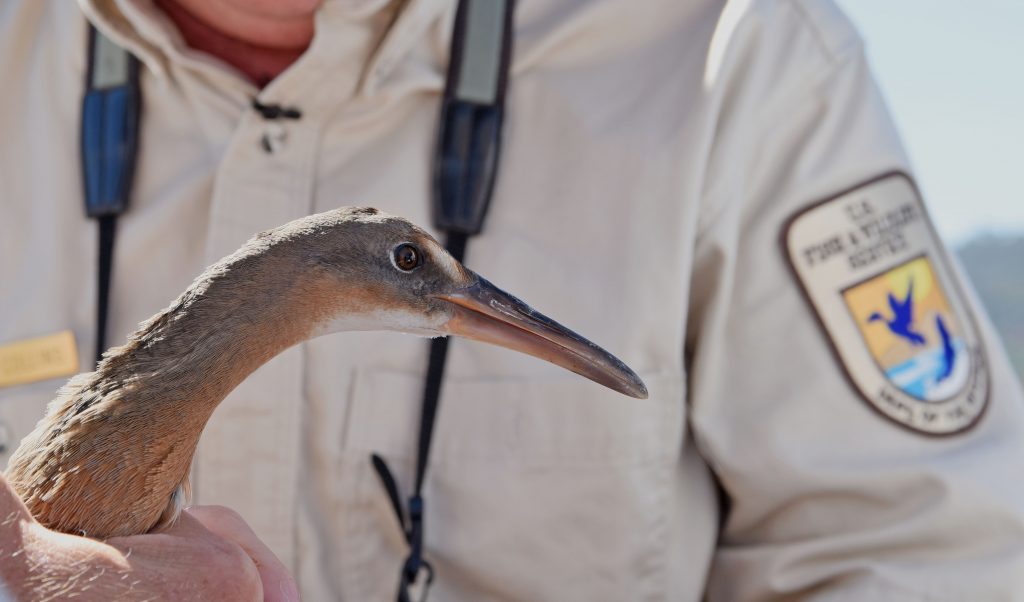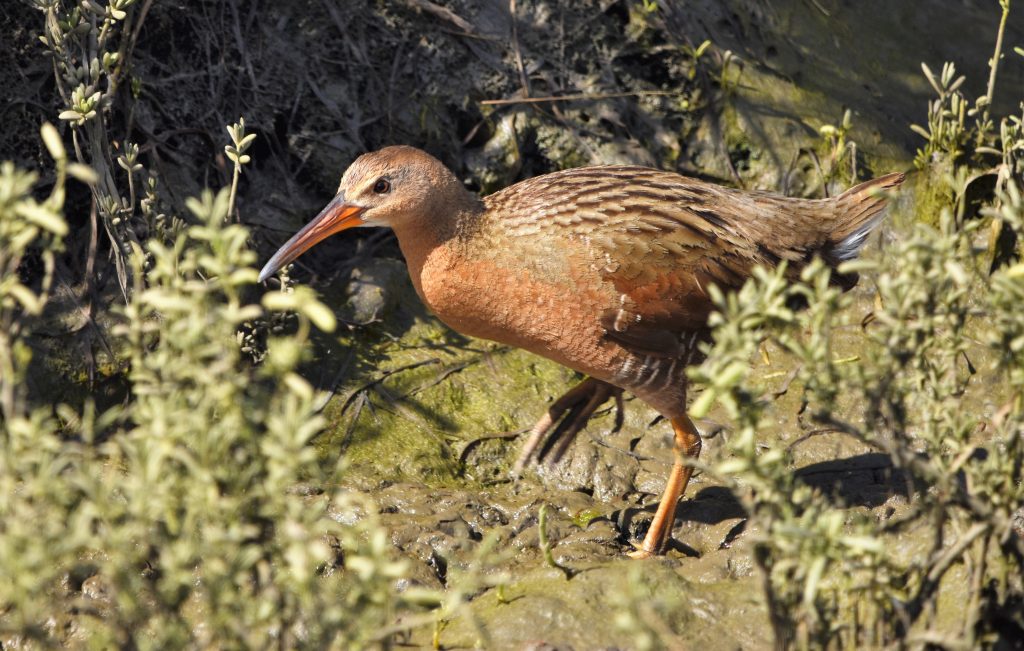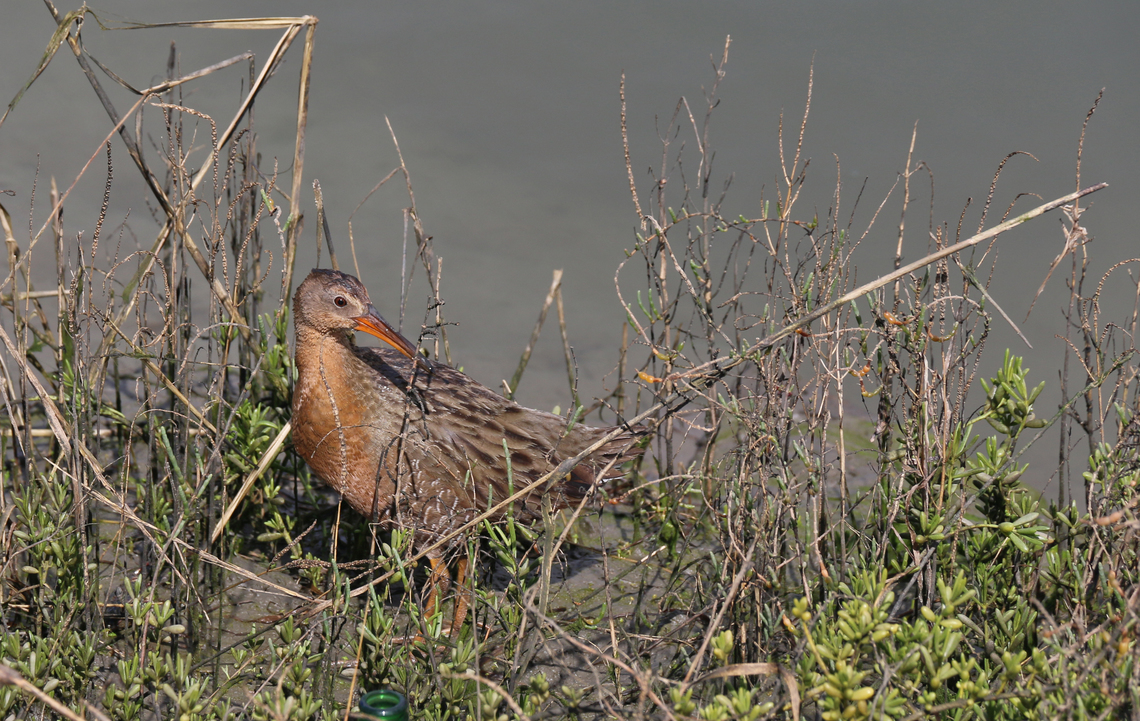By Sandra Hamilton, Fish & Wildlife Biologist, Listing & Recovery Division, U.S. Fish & Wildlife Service
Named for its long, rail-thin legs, the secretive Light-footed Ridgway’s Rail (Rallus obsoletus levipes), a subspecies of the Ridgway’s rail, is a state and federally endangered species that resides in the coastal salt marshes from Southern California into Baja California, Mexico. Currently up for 5-year review, the U.S. Fish and Wildlife Service (Service) is in the process of analyzing the current status of the species and assessing the threats facing it. Numerous threats continue to impede the Light-footed Ridgway’s Rail (rail) recovery such as habitat degradation, predation, and the effects of climate change and sea level rise. However, the extent to which each of these factors impact the rail is unclear as knowledge gaps remain regarding the subspecies’ population dynamics including dispersal, movements, and connectivity among populations. In addition, knowledge of their abundance and distribution in Mexico is lacking. Addressing knowledge gaps and gaining a better understanding of these dynamics is critical for effective recovery and management actions.
Along with ongoing recovery efforts to protect and restore salt marsh habitat, the Service and its partners have identified some future work to help close these knowledge gaps. This includes implementation of standardized survey techniques, evaluation of movements of captive-bred and wild-caught rails, and an assessment of the rail population and habitat quality in Mexico. The implementation of a standardized survey method will not only provide a more rigorous estimate of population abundance within marshes range-wide, it will give us a more reliable estimate of population-wide trends and allow us to better measure the success of recovery efforts.

One of these recovery efforts has been to supplement wild rail populations in Southern California through a captive rearing program. Born out of a partnership between the U.S. Fish and Wildlife Service, Living Coast Discovery Center, San Diego Zoo Global, SeaWorld San Diego, and the California Department of Fish and Wildlife—and going strong for 20 years now—the program has released about 500 birds into the wild. In addition, the program has revealed the potential for rails to disperse farther than previously thought (see the story of one captive bred and released bird, nicknamed “Amelia”, in a previous SJV article here). However, in-depth knowledge of the movements of rail population as a whole remains largely unknown.
To help assess uncertainty regarding dispersal and connectivity among rail populations, one proposal involves attaching solar-powered GPS transmitters to both wild-caught and captive-bred rails. This project will allow researchers to evaluate the survival and dispersal of post-release rails in comparison to wild rails, providing valuable insight into the effectiveness of the breeding program. It will also provide knowledge about population connectivity, which researchers can use to help encourage recolonization of restored habitat, and to manage for genetic diversity. Continued tracking of the rails has the potential to reveal more previously unknown movements, including potential connections to populations in Mexico.

Greater knowledge of rails and their habitat in Baja California, Mexico, is especially important as suitable marsh habitat in Southern California continues to decline. With anticipated sea level rise, rails and their habitat in Southern California are at risk of getting squeezed out, caught between the encroaching sea edge on one side, and the barrier of urban development on the other. In Baja California, the potential to adapt to these changes is greater due to a higher availability of upland habitat. Upland habitat not only provides valuable refugia for rails during high tide, but can also help ensure the persistence of the habitat long-term. With continued management, the opportunity for habitat migration is much greater in Baja California marshes, indicating these habitats may be very important for the future recovery of the rail.
By addressing these knowledge gaps, the Light-footed Ridgway’s Rail and its habitat will be better suited to face ongoing environmental changes. With continued collaboration and partnerships, the U.S. Fish and Wildlife Service remains committed to learning more about the elusive Light-footed Ridgway’s Rail and applying our knowledge to the long-term recovery of the subspecies.

